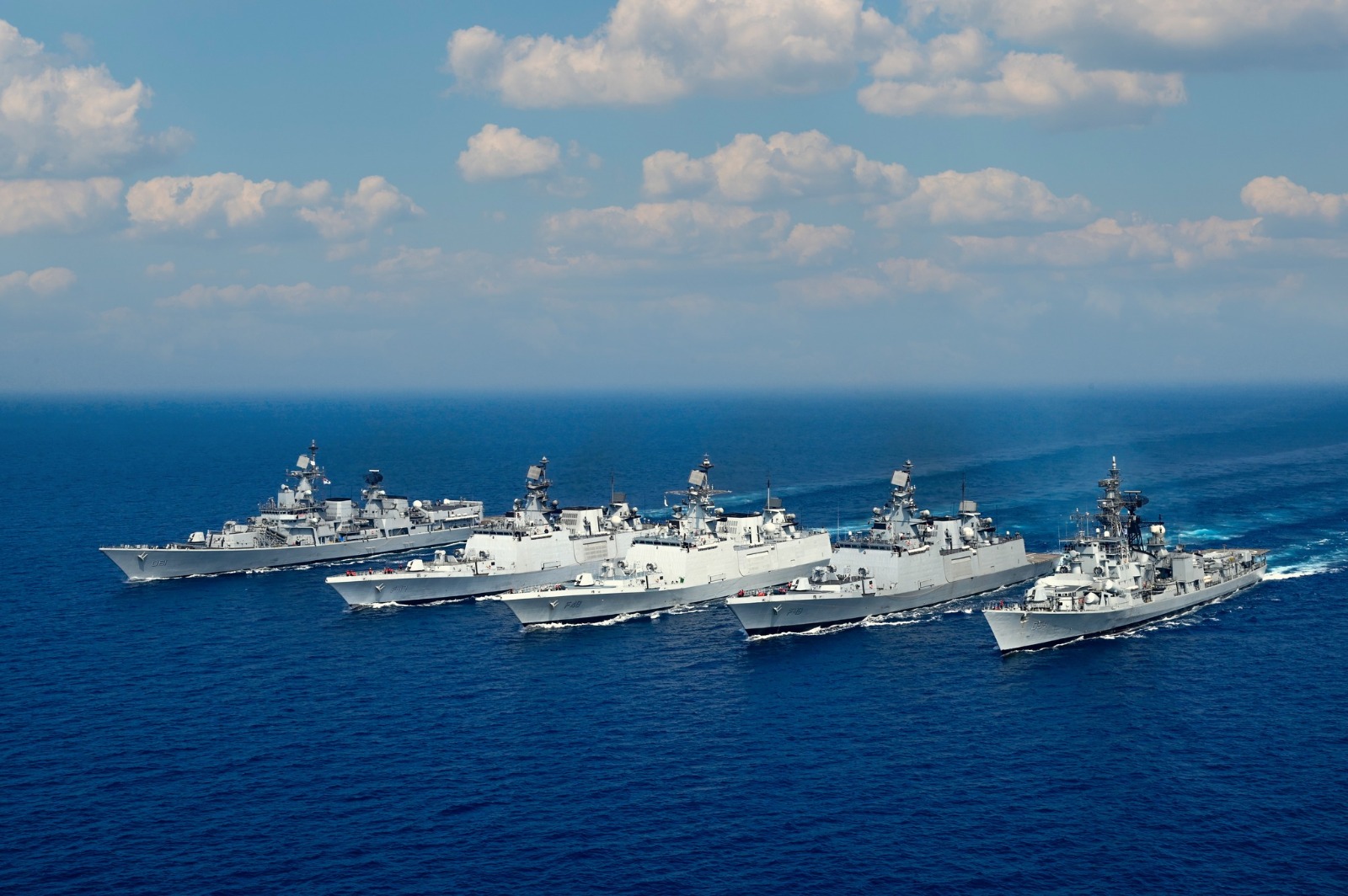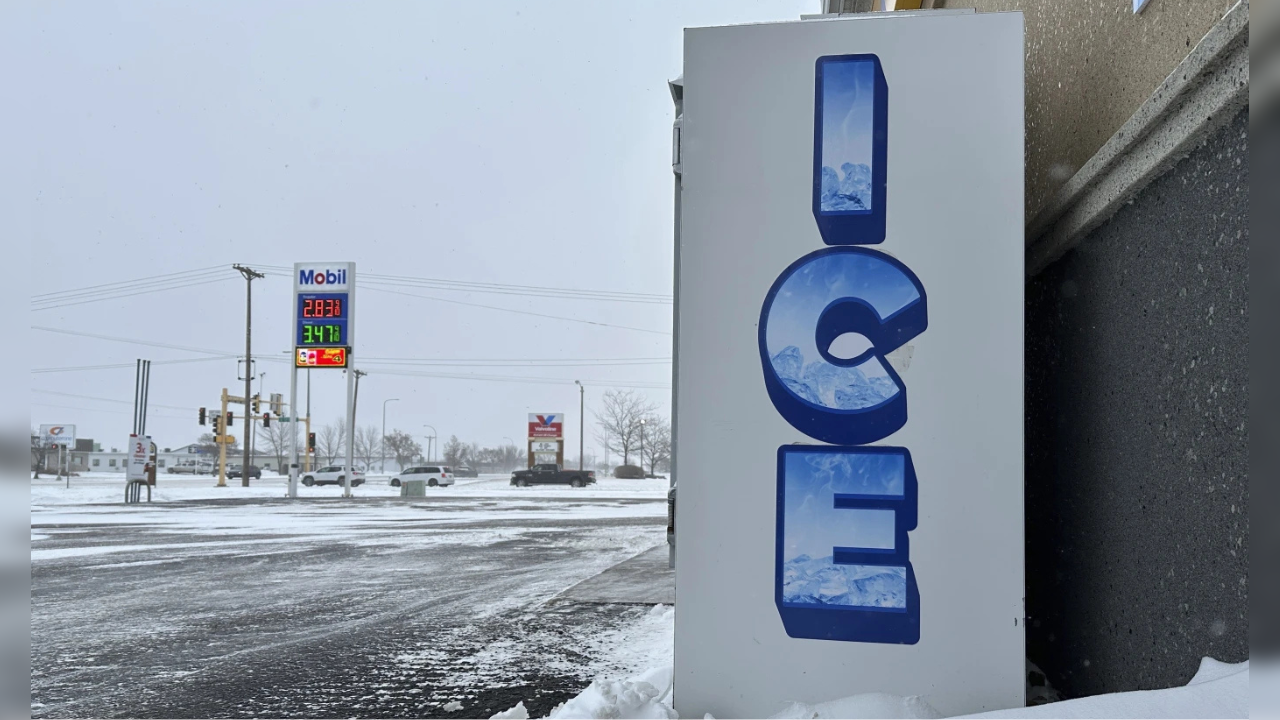Infra
Indian Military Bases At INS Baaz, CAR Nicobar See Renewed Infra Push As QUAD Nations Look To Counter ‘Hostile’ China

With China’s unprecedented rise and belligerence, global geostrategic action has begun to shift from the South China Sea (SCS) to the larger Indo-Pacific region.
The US already has a huge air asset presence at Andersen Air Force Base in Guam. The 18th Wing at Kadena Air Base, Okinawa, Japan, is the largest U.S. military installation in the Asia-Pacific region and the largest wing in the US Air Force (USAF).
Both are Island territories. On 18 March 2016, the United States and the Philippines signed a deal to allow US forces to use five bases in the country, including Antonio Bautista Air Base, to counter Chinese deployments in the Spratly Islands.
However, there are other Island airfields in the Indian Ocean Region (IOR) that can greatly impact operations in SCS and north-eastern IOR. These are Diego Garcia (British Indian Ocean Territory), Cocos (Keeling) Islands (Australian external territory), INS Baaz at Campbell Bay, and the IAF airbase at Car Nicobar (Great Nicobar, India).
While Diego Garcia is a well-established US/UK joint military base housing US bomber aircraft, the others are strategic locations with runways and have great potential for becoming major military airbases. These airbases are territories of QUAD nations which are working to contain China’s aggressive designs. It is thus interesting to steady them.
Diego Garcia Military Base Evolves
Archipelago: Chagos Archipelago
Diego Garcia is located in the northern half of the Indian Ocean, around 7 degrees south of the Equator, south of Maldives. The Island has an area of 30 sq. km. It is administered by the United Kingdom but claimed by Mauritius.
Diego Garcia and the rest of the Chagos islands were uninhabited until the late 18th century. Diego Garcia became a colony of the UK after the Napoleonic Wars as part of the Treaty of Paris (1814), and from 1814 to 1965, it was administered from Mauritius. It is often referred to as “Fantasy Island” for its seclusion.
In 1942, the British opened RAF Station Diego Garcia and established an advanced flying boat unit. During World War II, both Catalina and Sunderland aircraft were flown in search of Japanese and German submarines and surface raiders.
It was one of the “Dependencies” of the British Colony of Mauritius until the Chagos Islands were detached for inclusion in the newly created British Indian Ocean Territory (BIOT) in 1965. In April 1967, the BIOT Administration bought out Chagos-Agalega for £600,000, thus becoming the sole property owner in the BIOT. The total population today is a little over 4,000. Diego Garcia is a fully militarised atoll and the largest of the 60 small islands of the Chagos Archipelago.
In the early 1960s, when the UK was withdrawing its military presence from the Indian Ocean, the United States requested an unpopulated island, and ultimately, Diego Garcia was found suitable.
Between 1968 and 1973, the Chagossian inhabitants were forcibly expelled from Diego Garcia by the UK Government so that a joint US/UK military base could be established. The United States built the large Naval Support Facility, which has been in continuous operation since then.
In 2019, the continued British administration of the archipelago was deemed illegal by the International Court of Justice in The Hague, a ruling the United Nations General Assembly supported. However, the British dismissed this ruling as not legally binding.
In June 2020, a Mauritian official offered to allow the United States to retain its military base on the island as long as Mauritius was given sovereignty over the Chagos archipelago.
US-UK Agreement
On 30 December 1966, the United States and the UK executed an agreement that permitted the United States to use the BIOT for defense purposes for 50 years until December 2016, followed by a 20-year extension (to 2036). No monetary payment was made.
Diego Garcia Strategic Location
The United States saw the atoll as the “Malta of the Indian Ocean.” The atoll is located 3,535 km east of Tanzania’s coast, 1,796 km south-southwest of the southern tip of India (at Kanyakumari), and 4,723 km west-northwest of the west coast of Australia. The distance from Diego Garcia to Malacca Strait is 3,289 km and 6,292 km to Taiwan. Thus, it is a little far from SCS but is very centrally located to dominate the Indian Ocean.
The atoll continues to play a key role in America’s approach to the Indian Ocean as a flexible forward military hub that can facilitate a range of offensive activities.
The US maintains significant forward logistics facilities and supply ships. There are around 20 ships, some of which provide rapid-response delivery of equipment to ground troops. There were logistics vessels to service the rapid delivery requirements of the USAF.
Diego Garcia Airbase
In 1980s, Diego Garcia got its two 12,000-foot-long (3,700 m) parallel runways, expansive parking aprons for heavy bombers, 20 new anchorages in the lagoon, a deep-water pier, port facilities for the largest naval vessels in the U.S. and British fleets, aircraft hangars, maintenance buildings and an air terminal, a 1,340,000 barrels fuel storage area, and billeting and messing facilities for thousands of sailors, airmen, and support personnel.
The island was designated as one of the emergency landing sites worldwide for the NASA Space Shuttle, though never used.
The closure of the U.S. bases in the Philippines in the early 1990s brought many workers from Subic Bay and Clark Airbase to Diego Garcia. At any given time, 3,000 to 5,000 US troops and civilian support staff live on the island.
In 2020 Pentagon confirmed that three American B-2 Spirit stealth bombers had deployed from Whiteman Air Force Base in Missouri to Diego Garcia. In 2021, B-1B Lancer jets were once again deployed in Diego Garcia for the first time in more than 15 years. In April 2024, the United States deployed two B-52 bombers to the Indian Ocean as part of its Pacific Air Forces’ training program.

Increased Importance For Gulf Operations
The base was important in view of the US setbacks in Vietnam and Cambodia, the closure of the Peshawar Air Station listening post in Pakistan and Kagnew Station in Eritrea, and the build-up of the Soviet naval presence in Aden and a Soviet airbase at Berbera, Somalia.
Its importance increased further following the fall of the Shah of Iran and the Iran Hostage Crisis in 1979–1980. The West became concerned with ensuring the flow of oil from the Persian Gulf through the Strait of Hormuz.
The island provided an “unsinkable aircraft carrier” for the United States during combat operations from the atoll against Afghanistan (2001–2006) and Iraq (2003–2006). A number of allied militaries, including Australia, Japan, and the Republic of Korea, were based on the island. Since July 2006, the US facilities have been known as Camp Thunder Cove.
In recent years, relations between India and the United States have improved dramatically. Diego Garcia has been the site of naval exercises between the United States and Indian navies.
Cocos (Keeling) Islands
Cocos (Keeling) Islands is an Australian Indian Ocean External Territory comprising a small archipelago approximately midway between Australia and Sri Lanka and relatively close to the Indonesian island of Sumatra.
The islands were discovered in 1609 by the British sea captain William Keeling, but no settlement occurred until the early 19th century. Name Cocos refers to the abundant coconut trees, while Keeling refers to the discoverer. The Island was annexed by the United Kingdom in 1857. In 1946, the administration of the islands reverted to Singapore, still under British rule.
Later, on 23 November 1955, it was transferred from Singapore to Australia. Until 1978, virtually all of the territory’s real estate still belonged to the Clunies-Ross family, the first settler, a Scottish merchant. Australia then forced the family to sell the islands for A$6,250,000, using the threat of compulsory acquisition.
It has a total area of 14 sq. km and a highest elevation of 5 m (16 ft). The territory consists of two atolls made up of 27 coral islands, of which only two—West Island and Home Island—are inhabited.
Much of the island’s current population of around 600 is descended from the Malay copra plantation workers. They mostly practice Sunni Islam and speak a dialect of the Malay language.
Military Activities On The Island
During WW II, after the Fall of Singapore in 1942, the islands were administered from Ceylon and West and Direction Islands were placed under Allied military administration. The islands’ garrison initially consisted of a British infantry platoon. On 25 December 1942, the Japanese submarine I-166 bombarded the islands but caused no damage.
Later in the war, two airstrips were built, and three bomber squadrons were moved to the islands to conduct raids against Japanese targets in Southeast Asia and provide support during the planned reinvasion of Malaya and the re-conquest of Singapore. The first military aircraft to operate were the Royal Air Force’s Supermarine Spitfire Mk VIIIs and Liberator bombers.
Military Presence At The Airstrip
The airstrip on West Island was around two kilometers long and designed to accommodate passenger Boeing 737s and small military planes. The United States had been using the airstrip for several decades as a stopover point between Diego Garcia and Guam and as a partial alternative to the Paya Lebar Airbase, Singapore.
In 2016, the Australian Department of Defence announced that the West Island would be upgraded to support the Royal Australian Air Force’s P-8 Poseidon maritime patrol aircraft. Until 2023, there were no active military installations or defense personnel on the island. In 2023, the Australian parliament approved plans to extend the airstrip.
Construction was scheduled to start in 2024 and be completed by 2026. The Royal Australian Navy and Australian Border Force also deploy Cape and Armidale-class patrol boats, and Arafura-class offshore patrol vessels to conduct surveillance and counter-migrant smuggling patrols in adjacent waters.
Strategic Importance Of Cocos (Keeling) Islands
The Cocos Islands are strategically important because of their proximity to shipping lanes in the Indian and Pacific oceans. The islands could be used to monitor the Malacca, Sunda, and Lombok straits. The distance from the Cocos (Keeling) Islands to Malacca is 1,702 km, to Sunda Strait (1,208 km), and to Lombok Island (1601 km).
The United States and Australia have expressed interest in stationing surveillance drones on the Cocos Islands. Australia is now actively supporting increased American presence in Southeast Asia, even at the cost of upsetting China. It is part of the US “pivot” towards Asia, facilitating control of the sea lanes and potentially allowing US forces to enforce a blockade against China.
Australia views the Cocos as a long-term strategic location. In 2023, Indian Navy and Air Force aircraft visited the islands. Australia hopes to further advance its relationships with India to grow its monitoring strength in the Indian Ocean.
Air Force Station Car Nicobar
Car Nicobar is located in the Andaman and Nicobar Islands, in the Bay of Bengal, at roughly 9 degrees north of the equator. The Island is 15 km long and 12 km wide, has a 51 km coastline, a max elevation of 10 m (30 ft), and an area of 126.9 sq. km. The population is around 18,000. Car Nicobar is remarkably flat except for some cliffs in the north.
Car Nicobar is 270 km south of Port Blair. Normally, a ship is available twice a week to Port Blair. Indian Air Force (IAF) operates charter services between Port Blair’s Veer Savarkar International Airport, Campbell Bay, and Car Nicobar Air Force Base.

Pawan Hans helicopters also regularly service Car Nicobar, Port Blair, and other islands of the Nicobar district. Under a July 2024 agreement, a 19-seater fixed-wing aircraft will operate between Port Blair, Car Nicobar, and Campbell Bay with Flybig, a Gurugram-based private company under Big Charter Private Limited.
The 37 Wing, Air Force Station Car Nicobar, has an area of 204 hectares (504 acres). The 914-metre (3,000 ft) bitumen runway was built by the Japanese during their occupation of these islands between 1942 and 1945.
After 1945, it was used by the British Royal Air Force as a refueling base for regular flights between RAF Negombo (now Colombo International Airport) in Sri Lanka (then Ceylon) and RAF Changi in Singapore (& vice versa). The runway was extended to 2,717 meters (8,914) by the IAF in 1967. The IAF airbase at Car Nicobar is at 2 m (5 ft) elevation. The runway length is being further extended by 150 m. The first Mi-8 helicopter arrived here in 1982.
The air station was devastated by the 2004 Indian Ocean earthquake and tsunami when 116 IAF personnel and family members died. Little remained of the air base. IAF personnel worked night and day: the runway was repaired, navigational aids were installed, and the basic infrastructure was restored. On 14 April, just three-and-a-half months later, the Car Nicobar Air Station resumed operations.
IAF Jaguar (Maritime) and Su-30 MKI have operated from the airbase. The C-130J has landed. Infrastructure at the base is coming up, and one day, it will be possible to station a fighter squadron permanently.
Situated in the middle of 572 Island, 720 km long, A&N cluster, the Carnic airbase virtually straddles one of the major trade routes of the world. “Two strategic waterways, the six and ten-degree channels, pass through here. Though nearly 1,200 km from Kolkata and Chennai, the A&N are 200 km from Myanmar, and the Chinese military “listening” post at Coco Islands leased from Myanmar is just 45 km away from the northernmost islands.
The distance from Car Nicobar to Malacca Strait is just 900 km. A Su-30 operating from Carnic can make a combat mission till the middle of SCS with just one aerial refueling.
Campbell Bay – INS Baaz
Campbell Bay, INS Baaz, is India’s southernmost regular airstrip, located about 7 degrees north of the equator. The island’s Indira Point is famous for being the southernmost point of India.

INS Baaz naval station was inaugurated on 31 July 2012. It is a full-fledged “forward operating base” of the Indian Navy. It overlooks the six-degree Channel, one of the most crucial shipping lanes in the world, a vital choke point. It will soon become India’s eye over the Malacca Strait and the Bay of Bengal. There is a 1,050m (3,445 ft) asphalt runway.
The Naval Air Station provides requisite logistic, communication, and administrative support for various aircraft undertaking surveillance, patrolling missions, and maritime air operations. The strategically located INS Baaz will enable India to extend its reach in the eastern Indian Ocean region.
Currently, only the Dornier 228 aircraft and some helicopters operate here regularly. The IAF C-130J Super Hercules transport aircraft can also operate. Plans are underway to extend the runway to 10,000 feet to accommodate the Indian Navy’s Boeing P8i Poseidon surveillance aircraft with anti-submarine capabilities.

A separate international airport and harbor with a cargo terminal are also planned for Campbell Bay. Land acquisition is underway.
Way Ahead
India formed the integrated tri-service Andaman and Nicobar Command (ANC) in 2001. It overlooks the critical trade routes and choke points through which over 94,000 merchant ships cross every year, carrying the world’s 40 percent freight trade to and from China, South Korea, and Japan.
China has militarized reclaimed tiny islets in SCS and created major disputes with many ASEAN neighbors. China has also put into question the freedom of seas and navigation.
Australia is working towards expanding the Cocos Islands. India has been working on expanding military air and naval facilities in the Bay of Bengal. The IAF airbase at Car Nicobar is being upgraded to hold fighter squadrons.
The runway at INS Kohassa, Shibpur, North Andaman Island, will one day have new ammunition dumps and capacity upgrades for fighter jets and bigger planes like long-range maritime reconnaissance Boeing P-8I and anti-submarine aircraft.
INS Baaz at Campbell Bay will initially get a runway extension from 3000 to 6,000 feet, later to 10,000 feet. The IAF already maintains air defenses, fielding short and medium-range SAMs under ANC. The army’s single brigade is planned to be increased by deploying a division-size force (about 15,000 troops) under ANC.
The Indian Navy will increase berthing facilities for ships and submarines. A proposal to develop Lakshadweep islands with longer runways is also being considered.











